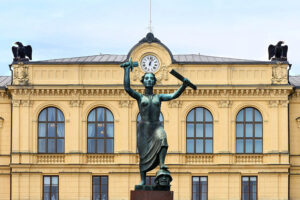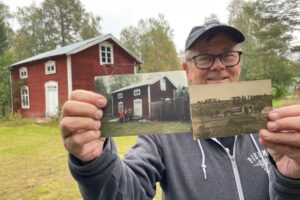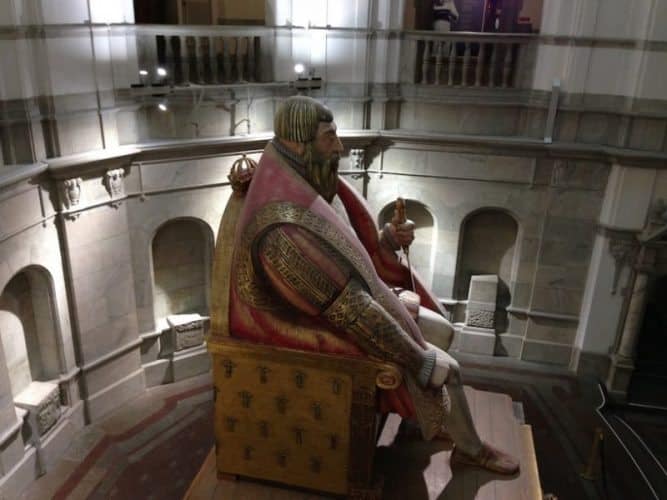
Memorable Museums in Stockholm, Sweden
By Faye S. Wolfe

When you visit a city, is your first stop its museums?
In Stockholm, you can take in a rich cultural smorgasbord of art, artifacts—even motorboats—on the peninsula of Djurgarden in the middle of Stockholm.
Shaped like the foot of a rampant lion on a coat of arms, Djurgarden dips its toes in the city’s lively viken, the Swedish word for bay or inlet.
Much of it is parkland, with the museums toward the western end, and it’s easily reachable from other parts of the city by public bus or ferry (my preference: I love any excuse to take a boat ride).
There’s also a tram line running through Djurgarden and from Norrmalmstorg that has vintage cars as well as modern ones. Ferries go from the Slussen transit area at the foot of Gamla Stan, the old town.
First Stop: The Nordiska Museet
Those used to the standard glass museum entrance might hesitate coming upon the imposing wooden doors of the Nordiska Museet as if opening them could constitute a form of trespass.
Trepidation gives way to awe once you venture in.
The day I ducked out of a summer drizzle and into the Nordiska, I was met by the sight of pale Northern light filtering down into a vast central hall from the leaded-glass skylights four stories above.
Opposite me was the much-larger-than-life painted wood figure of Gustav Vasa, the first king of Sweden—imposing but also approachable, squarely seated on his throne, with his red shoes and chunky bare knees.
The painted wood statue looks ancient, but it was made in 1925.
The building too, at least to a wide-eyed American, looks far older than it is (1907), thanks to an exterior lavishly adorned with spires, balconies, cupolas, curvaceous Dutch gables, and soaring pillars, inlaid floors, and general opulence of its interior.
The English-language version of Nordiska’s website is called “Know Thyself,” an invitation, really, to those who believe that the objects we cook with, sit on, dress in, amuse ourselves with, and employ to commune with ourselves, our families, and the divine reveal fascinating answers to primal questions of who we are and were.
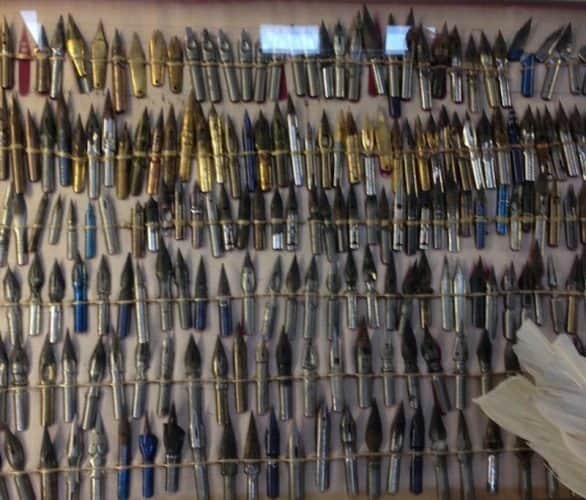
If exploring the deeper meaning of objects doesn’t appeal to you, you can take the Nordiska as an enjoyable, self-paced tutorial on Swedish culture, values, and history.
You can do right by the museum in just a couple of hours, although that would most likely mean forgoing peeks into the various cabinets where, for instance, lace samples reside.
This is not to say you should: sliding open one smoothly gliding drawer after another to reveal textiles generations of women wove, embroidered, and tatted for their homes and clothing can be mesmerizing.
At the least, you probably have to like things to like the Nordiska, because that’s what it’s all about. It also helps if you like a slightly old-fashioned sort of museum versus the glittery, brash, blockbuster-type institutions.
All Sorts of Things
Naturally, the Nordiska focuses on things Swedish, and if for you that conjures up IKEA, prepare to be happily overwhelmed.
With a collection of more than 1.5 million objects in all, the museum has its share of examples of contemporary design, but it also has an over-the-top 19th-century specimen heavy on the mother-of-pearl and red velvet.
And rooms upon rooms of glass cases filled with everything from pen nibs to beautiful, traditional red Sami caps, toys, clocks, paperweights, charmingly kitschy Nordic souvenirs, jewelry, beautiful hand-decorated antique Easter eggs, table settings from different periods.
Personal favorite: the tableau, set up as a dining room, representing the major Scandinavian holiday of Midsummer Eve.
The remains of a strawberry-and-whipped-cream cake still sit on the elegant table, there are wildflowers in a vase, golden light coming in at a slant through the window…
On the day I visited, I had a lot of these rooms virtually to myself, a rare treat these days when jostling museum crowds make it be hard to have an unfettered look and a quiet moment with what’s on display.
When you leave the Nordiska, you’ll have a firm idea of why the Swedish have such a gift for design, characterized by a lightness of touch, an embrace of light, simplicity, and restraint complemented by charming ornamentation.
Rooted in the natural beauty of the country, that design sense runs deep, deriving in part from Swedes’ ingenious and impressively graceful accommodation of the rigors of a northern climate and soul-testing long dark nights. Humor helps get you through, too: don’t miss the china figurine of a frog perched on a chamber pot …
Djurgårdsvägen 6-16; Open Monday–Sunday, 10.00–17.00; Admission: adults, 100 SEK, children 18 years and under, free; Phone: 8-519 546 00; more information: www.nordiskamuseet.se
A Jewel Box Museum
In contrast to the shadowy vastness of the Nordiska, the Liljevalchs down the way is small and approachable. Its architecture is early modern (it opened in 1916).
Unlike many later modern buildings in the brutalist style, colossal and cold, the Lijevalchs is human-scaled and inviting, with clean lines and a modest functionalism.
Each year, the museum hosts four exhibitions with a focus on art or design, including its Spring Salon, a juried show of artists’ work that is all for sale.
When I was there, the galleries were filled with a retrospective celebrating the prolific twentieth-century Swedish sculptor and ceramicist Hertha Hillfon.
Even the main hall, a bright, airy atrium, got in the act: at worktables and potter’s wheels, a bunch of children was intently trying their hand at working with clay.
The Liljevalchs installs four beautiful exhibitions a year, such as this retrospective of the works of Hertha Hillfon, one of Sweden’s most celebrated ceramic artists.
in the first room convincingly re-created Hillfon’s beautiful studio. Artful layouts encouraged scrutiny of the works of this remarkable artist.
This museum won’t take up a lot of your time (unless you pause for a fika—the Swedish form of a coffee break, usually involving a cinnamon roll, cookie, or cake—and people-watching in the atrium café), but it will capture and reward your full attention.
Djurgårdsvägen 60; Open Tuesday, Thursday 11:00–8:00, Wednesday and Friday to Sunday 11:00–5:00. Entrance to the current show, “Utopian Bodies: Fashion Looks Forward” (through Feb. 6, 2016) adults SEK 120, children under 18, free. Wednesdays free; 08-508 31 330; website
Through the Blue Gate
Speaking of cakes, mouth-watering confections await next door at the Blå Porten (Swedish for “Blue Gate”; Blå sounds something like blowa, spoken with your lips puckered.) The café’s pretty courtyard shares a wall with the Liljevalchs, and the aesthetic environment carries over into the restaurant that wraps around the other three sides of the courtyard.
When it’s balmy, you can sit in the courtyard on a chartreuse chair, sip your coffee, admire the plantings, and relax to the patter of the fountain. If the weather’s not congenial, you can decamp to the congenial atmosphere inside, made intimate and inviting with flickering tall white tapers on the tables, dark wooden floors and ceilings, and big windows that look out at the beautifully landscaped garden.
After the Liljevalchs, we treated ourselves to a late lunch at Blå Porten: a towering slice of quiche and a bowl of warming fish soup, both reasonably priced. It would also be a perfect spot for a fika on your Djurgarden museum sweep. Arrayed buffet style on rustic tables are salads, breads, sandwiches, and those beautiful desserts—jam tarts, lemon cake, chocolate torte, meringues, cookies, sweet rolls…
You can order hot dishes, such as salmon with dill mayonnaise and meatballs with potatoes and pickled cucumber, at the tiny counter. (As behooves a restaurant that has been in operation for a century, it serves food traditional to Sweden—with a light touch.)
Incidentally, if you’re a fan of Karl Ove Knausgaard’s enthralling series of novels My Struggle, you may be even more inclined to stop at Blå Porten. In Book 2, the author visits the restaurant with his wife and toddler daughter one winter Sunday.
Djurgårdsvägen 64 115 21; Open for lunch and dinner, check for times; 8-663 87 59; www.blaporten.com
The Vast Vasa
A 10-minute walk from the Blå Porten, back toward the Nordiska, is the Vasa Museet, the final port-of-call for the Vasa, a 17th-century ship that sank in Stockholm Harbor during its maiden voyage and was raised for restoration in 1961.
Don’t be put off by the crowds outside the museum; they may all be in the line reserved for bus tours.
When we went, we were able to breeze right up to the ticket desk and were craning our neck up at the three-story craft in just a few minutes. And if you’re inclined to skepticism about big tourist draws, this Museet is one of those that will make you a little shamefaced about your skepticism.
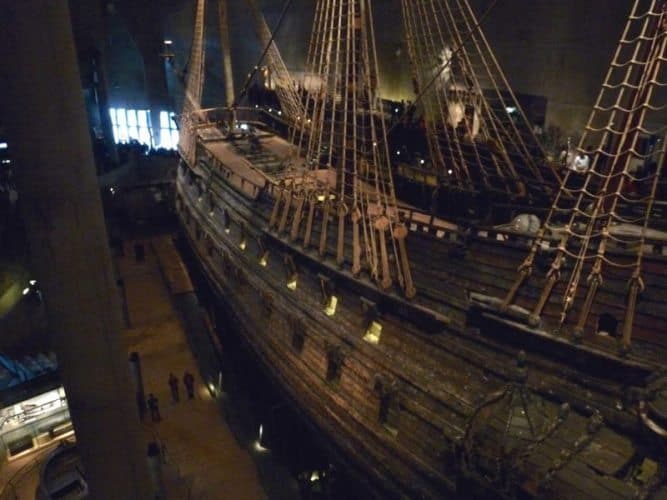
The Vasa is truly spectacular, as in, an amazing sight to see. For one thing, it is huge, 69 meters or so long, 19 meters tall. For another, it’s a massive work of art, ornamented with hundreds of carved wooden figures (mermaids, angels, soldiers, lions…).
You can take all this in, from various angles and at different levels, thanks to the clever design of the building. And surprisingly, it’s not hard to get an unobstructed vantage point most of the time: the museum is like Noah’s ark in its capacity to absorb people.
Like the Nordiska, the Vasamuseet is a shadowy place. Dramatic lighting and a soaring space amplify the experience of seeing a centuries-old relic reclaimed from the sea’s cold, dark, watery depths—and the feeling of peering at a world rendered shadowy by time.
\The Sami (once known as Lapps) are the indigenous people of Scandinavia and live today in the far north. Their culture and traditional crafts, such as these elaborately decorated felt caps, are celebrated in beautiful displays at the Nordiska Museum.
Another way it bends your mind: You start by being wowed by the Vasa and the technical achievements of its restoration, then find yourself face to face with the oh-so-personal nature of the disaster. The Vasa’s sinking was not just a military calamity for a seagoing nation seeking to impress its neighbors and enemies with its naval might and shipbuilding prowess.
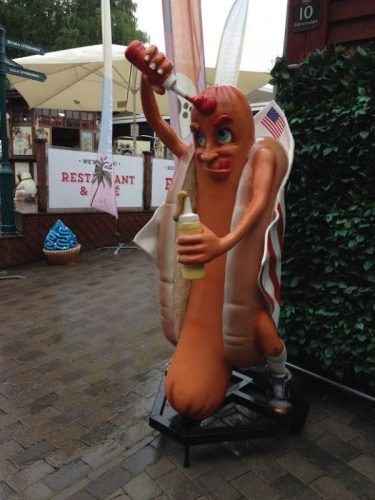
It was also a tragedy for many of its crew and guests who’d signed up for a celebratory outing. One example of the details that bring it home: the display case with a 16-year-old girl’s petite skeleton, her shoes, and a house key found in her pocket.
Galärvarvsvägen 14; open seven days a week; Admission: adults, 130 SEK, children up to 18 years, free; 8-519 548 00
Motorboats and More
Three museums in one day were our personal limit, but there is lots more to see on the island of Djurgarden in Sweden.
For traditionalists, Skansen, an open-air museum, has a village of historical houses, shops, a church, and various other buildings, architectural artifacts of an earlier, agrarian era collected and preserved by the founder of Nordiska a century or so ago. If the late 1970s seems like the ancient past to you, you might find the highly interactive ABBAmuseum a hoot.
Djurgarden also has a couple of niche museums just minutes away from the Vasamuseet. The Boat Hall 2 (open only during the summer) is a big, bare-bones space with about 50 boats of various kinds on display.
Maybe it sounds a tad specialized but consider the context: Stockholm is an archipelago, water, both fresh and salty, swirls around it and has set its character as much as that of bella Venezia.
What’s more, the craft within Boat Hall 2 are quite seductive in themselves, as well as physical evidence of how setting out to sea is encoded in Sweden’s cultural DNA. The Vasa was a failure, but these seaworthy boats are emblems of the country’s shipbuilding prowess.
Part of the much larger National Maritime Museum, across the water from Djurgarden, Boat Hall 2 is in picturesque Galarvarvet, a Djurgarden waterfront area that was once home to shipyards. (Its name refers to the naval galleys that were pulled up on the shore there 300 years ago.) Docked outside are Sweden’s first icebreaker and its last lightship, both open to the public in the summer.
Inside the hall, you can peer into and under, walk around, sometimes climb aboard, and otherwise take in the artistry and engineering of these sailboats, rowboats, fishing boats, gleaming wooden motorboats, steam launches, private yachts, and a sleek sloop fit for a king—in fact, a 1923 replica of a royal vessel. Admission is free.
All Things Boozy?
Practically next door is niche institution no. 2: the Spritmuseet, or Museum of Spirits, is described by the website Eater as “a museum that pays homage to all things boozy.” Don’t let the description fool you. It’s not the down-and-dirty pub crawl stop you might expect.
Besides its art gallery, tasting room, shop, and bar, the museum has a charming restaurant with an acclaimed chef in charge of the kitchen. Previously making a name for himself at La Gazzetta in Paris, Peter Nilsson returned to his native Sweden to run the kitchen of the Spritmuseet’s restaurant in April 2015
- These 9 U.S. National Parks Require Reservations in 2024 - April 17, 2024
- Take a Hike in Olympic National Park - April 17, 2024
- The Wild Mississippi: 2340 Miles Across Ten States - April 8, 2024


